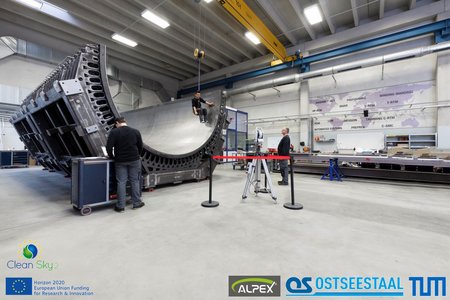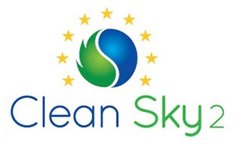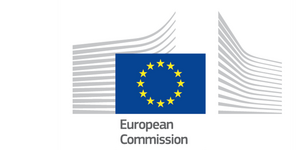EMOTION – Enhanced Mould for Thermoplastic Fuselage in and out of Autoclave Consolidation
The EMOTION project provides a tool that enables the production of high volume half-shells from thermoplastic fibre composite. The tool will be used in the CS2 joint project STUNNING.
Project Partners
ALPEX GmbH, Ostseestaal GmbH & Co KG, Topic Leader: NLR - Netherlands Aerospace Centre
Duration
01.09.2019 – 01.03.2022
Funding authority
EU HORIZON 2020 – Clean Sky 2 Joint Undertaking
Motivation
First of all, a tool with a diameter of approx. 4m and a length of 8m is developed and manufactured to produce a fuselage half shell. The intended process chain uses 2D placed laminates, gripped mechanically and placed in the tool, secured in position by means of a vacuum bag and consolidated in the autoclave under pressure and up to 400°C temperature. The high processing temperatures pose a challenge in terms of thermal expansion, resulting in distortion of the fibre architecture and the component as a whole, as well as in terms of energy consumption. The use of different alloys and a partially flexible substructure are to develop new approaches to industrial suitability. In a second step, technologies for consolidation outside of an autoclave on a tool part segment will be investigated. Energy savings, reduced use of auxiliary materials and thus cost savings are to strengthen the competitiveness of the industry. The development and provision of a tool with a diameter of approx. 4m and a length of 8m for the production of a fuselage lower shell is to prove the developed solution approaches.
Method
Ostseestaal, specialized in the forming of large metal components and molds, supplies the basic structure of the tool. The tool developer and constructor Alpex processes these into a ready-to-use tool. TUM supports the development and design process with material and process knowledge and preliminary tests. In the concept phase, different solutions are examined in the network and risks are evaluated and minimized by accompanying tests. The first project phase concludes with testing and handover of a fully scaled tool for the production of a fuselage shell segment. In the second part of the project, a novel tool concept will be developed to meet the requirements of a consolidation without autoclave. The process development based on direct consolidation and post-crystallization by means of a heatable tool is carried out at TUM. Due to the development risk, the implementation is carried out on a segment of the large tool.
Project Summary
The EMOTION project was closed successfully end of February 2022. TUM would like to thank its project partners ALPEX and Ostseestaal very much for the successful cooperation. Special thanks also go to NLR as Topic Manager, which was responsible for topic setting and coordination with related CleanSky 2 projects and testing the suitability of the newly developed tool. An overview of the project's progress is provided in the public summary below. Feel free to contact TUM or one of the project partners, if you are interested to learn more about high temperature tooling appropriate for the use of thermoplastic composite production.

The EMOTION project provides a tool that enables the production of high volume half-shells from thermoplastic fibre composite. The tool is used in the CS2 joint project STUNNING, contributing to the Multi-Functional Fuselage Demonstrator.
Composite structures are used for latest airliner generation. Further improvement for the airframe lightweight structure shall be achieved by using thermoplastic based composite materials. While the use of carbon fibres as strong and stiff material remains the same, the matrix materials shall be changed to thermoplastics. This change is also motivated by potential improved end-of-life properties, e.g. meaning improved recyclability.
Lightweight structures are essential for the environmental friendly operation of airliners and in general mobility providers. Less weight, means more passenger or freight can be transported at same CO2 footprint. New propulsion technologies will not replace this need for lightweight structures. Instead, electrification and hydrogen technology in the area of propulsion require further improvements in lightweight construction to compensate for lower energy storage densities. Thermoplastic composite structures are stacked from several thin plies which need to be consolidated to a solid and strong material. Consolidation means that a pressure of up to 10 bars and temperature up to 400°C is applied to the stacked material. Doing that, a shape-defining tool is required which resists the temperature and pressure applied by an autoclave.
The EMOTION consortium is researching durability and process suitability such as temperature and consolidation pressure with the aim of achieving the best interaction between mold and component. During component manufacturing, the composite material is positioned at room temperature but need to be heated up to 400°C for consolidation later. The tool material (typically metal) as well as the composite material will expand and shrink during that operation. The difference in thermal behaviour causes the challenges. In the worst case the metal tool resists the temperature, but the manufactured composite structure is affected by wrinkles. Wrinkles in the fibre architecture reduces the strength of a composite material. Therefore, EMOTION project is looking for a solution and providing a process equipment to keep the reinforcing fibres perfectly aligned.
Carbon composite materials itself creates due to their energy intensive production a relative high CO2 footprint. By using thermoplastic matrix materials, processing temperatures rise and therefore energy efficient processing technologies are requested to provide an overall benefit in terms of ecological footprint.
The EMOTION project is therefore split into a near term and midterm technology approach. Processing in an AC is state of the art and can provide superior consolidation qualities. Processing out of an AC (ooA) is an objective for energy reduction, making thermoplastic composites even more competitive and providing a reduced ecological footprint.
The EMOTION project has shown at the end, that both approaches are based on same technological keys: 1) Use of special alloys for the mould skin addressing the CTE differences between tool and component 2) Multi material tool design capable to handle inhomogeneous thermal expansions. Both set up the base for an induction heated tooling system which can replace the AC operation.
While the near term approach was demonstrated by the joint project STUNNING by using the EMOTION tool for the skin manufacturing of the Multi-Functional Fuselage Demonstrator, the scaled midterm approach has demonstrated the basic feasibility of an inductively heated shell mould. Further research is required to qualify composite laminates, consolidated within temperature gradient affected conditions. Developments are required to improve midterm approach to a robust and reliable industrial level.
Acknowledgement
The project is made possible by the support of the European Union within the framework of the HORIZON 2020, Clean Sky 2 program.

